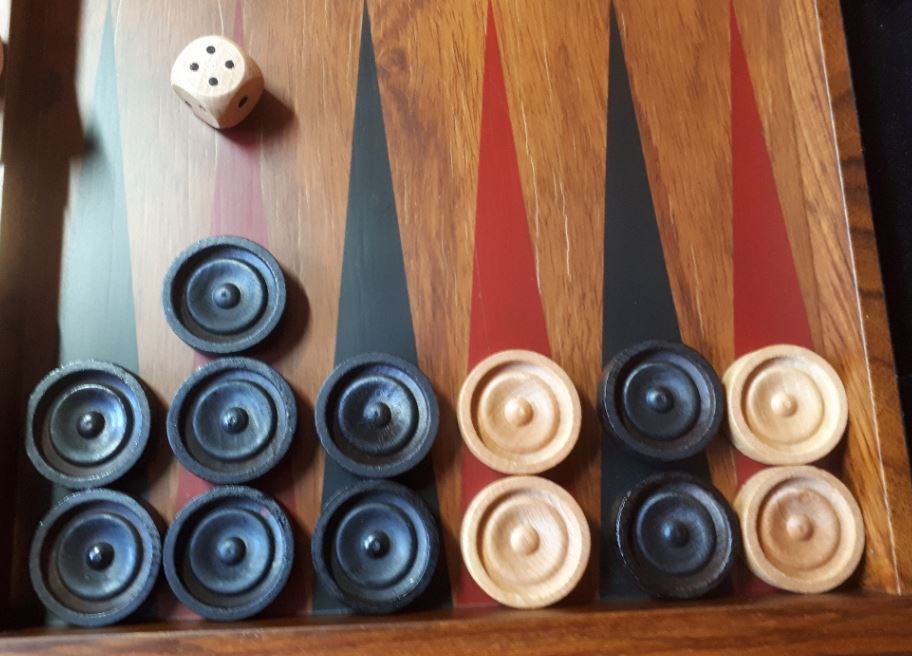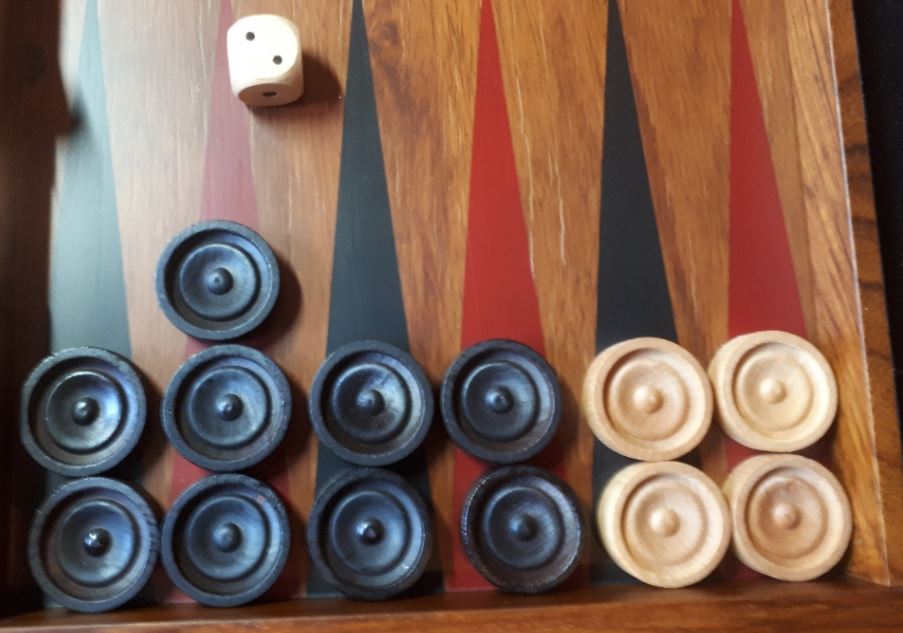Last updated on October 29, 2022
The backgammon back game is not a strategy of choice. It is forced upon players because they have been hit on multiple occasions and are behind in the race. The objective is to maintain two or more anchors in your opponent’s home board and wait for an opportunity for a late hit. The ideal number of anchors is two, any more is a waste of material. Playing this tactic from the start would be risky. This is because if it fails there is a strong likelihood of losing by a gammon (double the stake). This is a strategy designed to salvage a game when you have fallen behind. Your other checkers should be sufficiently advanced so as to block your opponent’s checker when it returns from the bar. You really need two anchors to play the backgammon back game strategy. If you only have one anchor it’s a holding game.
Risk
It can be really fun to play a back game and pull off a win from a seemingly hopeless position. However, it is not a starting strategy that should be adopted by choice. There is a big risk that comes with playing a back game strategy. When you don’t get that shot, or if you miss it, you often get gammoned or even occasionally backgammoned. Experienced players will not adopt this strategy by choice, it is always thrust upon them. However, some players intentionally hold back to play this backgammon strategy because they love this gambit so much. The thrill and satisfaction of winning using a back game strategy can be addictive, but it can also lead to significant margins of defeat.
Split anchors
When your anchors are several spaces apart, rather than being side-by-side in a prime, it is called a split back game. In this situation, it is easier for your opponent to bring his checkers home. Ideally, the split position should be avoided if possible. The ideal back game would be to have your anchors side by side as deep two-prime. However, always remember that the back game should be avoided at all costs. All of the other backgammon strategies are preferable to the back game. However, if you are forced into the back game strategy, commit to it and fight to the end. A surprise victory from a back game strategy can be extremely satisfying.
Another major problem with back games is that if you are playing an experienced opponent, they can often manipulate the game to keep you from maintaining proper timing. If you lose timing, what usually happens is that the checkers in your home board “crunch” to your lower points. When that happens, even if you hit a shot later, your opponent can still easily re-enter from the bar, leaping your checkers. Then they can race back around the board to win. Additionally, if your home board checkers are crunched on the lower points you can be forced to abandon an anchor on a high roll. For example, if all of your home board checkers are on the lower three points. A roll of 4 or higher, could force you to move a checker from your anchors.
Home board
The best backgammon strategy for playing a good back game, having established a couple of anchors deep in your opponent’s home board, is to build a very strong home board yourself. Ideally, 5 or 4-point prime on the higher points of your home board. This means that when you do get that opportunity to hit, it really counts. However, timing is everything. The strategy simply won’t work if you don’t get the timing right. If you are forced to ruin your home board with throws that you don’t want while your two anchors are trapped in your opponent’s home board, then hitting your opponent will be a hollow victory because they will be able to re-enter easily and take advantage of their lead in the race.
Deep anchors
If you are playing a back game strategy, the deeper your anchors are in your opponent’s board, the greater chance you have of success. Ideally, your anchors are going to be on two of the first three points. The deeper your anchors, the more likely you are to have a chance of hitting. The downside with deep anchors is that you are more likely to lose by a gammon as the checkers are so far from home. If the anchors are more advanced, such as the four or five points, you will have fewer opportunities to hit, but are more likely to avoid a gammon.
In a back game, there is generally no need to keep more than two checkers on an anchor. After all, you only need two checkers to secure a point. Any extra checkers would be better used as builders elsewhere on the field. Therefore, if you have more than two checkers on an anchor, try to escape the extra ones at the earliest opportunity to a position where they are more useful.
Related content
Backgammon rules are available on this link.



Why is the back game not a strategy of choice?
Hi Gary, it is a defensive strategy that has been forced upon you because you are behind in the race. Your back checkers are trapped in your opponent’s home board and you are simply waiting for an opportunity to hit. It’s hard to win from this position, although not impossible. At the beginning of the game, you are far better off trying other strategies, such as priming, racing and blitzing. Thanks for commenting.
Jason, I respectfully disagree. In 1977, I took Beckers book Backgammon For Blood, used his book and tweaked moves he recommended for a few decades and wona whole lot of money. Split anchors in opponents, 1 3 pt, is the ultimate. it is the only set up I use in the Back Game as nothing else can work often. You have to have at least one of your pieces on the bar, preferably 2 The back game with spit anchors in live, in person matches work extremely well, and after you recognize where you stand, after hundreds of thousands of games of experience, you will take their money. Controlling the doubling cube is a must. I can lose 30% of games played, losing a whopping 70% and still come out on top. The Back Game doesn’t work on line wiith computer because the dice ARE NOT random, the software algorithms set up by the software engineers reflect their ignorance of knowing how to play the game, the Running Game only. The repeated MAGICAL double 6’s and 5’s are painful and unbearable to see. Almost predictable, and it ruins the game. Yes, you are right, it is addictive, for 47 years that’s what I play, Playing the ‘running game is as boring as playing checkers with a 5 year old, ‘no double jumps allowed’ ! LOL. When playing live, in person with an experienced player, they can defeat my ‘back game’ intent most of the time by bombarding their bear off board constantly by taking chances, and sooner or later the dice will go their way, and then I’ll refuse their cube offer to double, or times 4. I wouldn’t recommend. this strategy to newcomers, as it takes years to hone your possibility awareness, but at least they should learn How to play the backgame. Thank you sir, no disrespect intended.
Hi David,
I have not read Backgammon for Blood, 1977 was a little before my time. I don’t think the book is still in print, but I might try to get hold of it. It sounds like you have mastered the back game strategy, well done. Not many backgammon players like the back game strategy and only play it when forced. I certainly fall in to that category! Thanks for taking the time to comment at Deluxe Backgammon, Jason